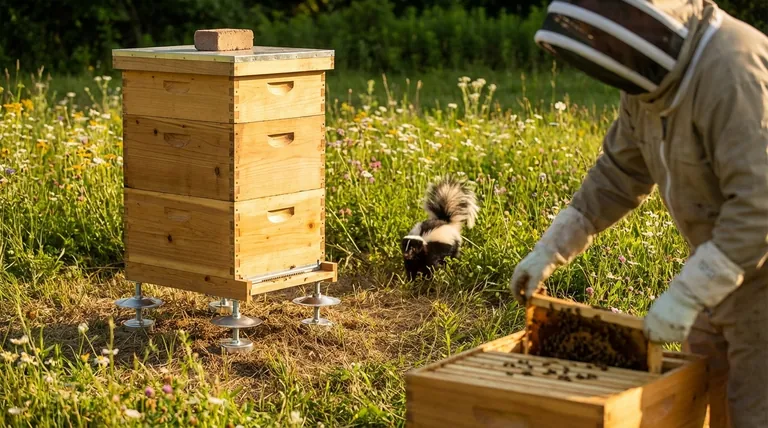For optimal protection and management, your beehive entrance should be positioned 16 to 18 inches off the ground. This specific height deters common ground-level pests like skunks while also placing the hive at a comfortable, ergonomic level for you to perform inspections and maintenance.
The question of hive height is not just about a single number. It represents a critical balance between pest defense, environmental control for hive health, and practical, long-term ergonomics for the beekeeper.

Why Hive Height is Critical for the Colony
Placing a beehive directly on the ground creates numerous, preventable problems. Elevating the hive on a stand is a foundational step in responsible beekeeping that directly impacts the colony's safety and well-being.
Deterring Ground-Level Pests
The most immediate benefit of an 18-inch height is pest control. Skunks, a common predator, will scratch at a hive entrance to lure out and eat guard bees. Raising the hive makes it awkward and difficult for them to stand on their hind legs and reach the entrance.
This elevation also provides a buffer from other curious ground animals and helps prevent ants from establishing a direct route into the hive.
Improving Air Circulation
Lifting a hive off the ground allows air to circulate underneath it. This is crucial for managing moisture, especially in humid climates or during winter.
Proper ventilation helps prevent condensation from building up inside the hive, which can lead to mold, mildew, and chilled bees. A dry hive is a healthier hive.
Protecting from Ground Dampness
A hive stand keeps the bottom board from sitting in damp soil, puddles, or melting snow. Constant contact with moisture will accelerate the rot of wooden hive components and can wick cold and dampness up into the colony, stressing the bees.
Optimizing for Beekeeper Ergonomics
While the bees' health is paramount, your own physical health is essential for long-term beekeeping success. The 16-to-18-inch standard is designed with the beekeeper in mind.
Reducing Back Strain
A hive at this height minimizes the need to bend over completely during routine inspections. This reduces strain on your back and knees, making the process of checking frames more comfortable and sustainable.
Easing the Lift of Heavy Supers
Lifting a honey super, which can weigh over 50 pounds, is demanding work. A hive that is too low requires you to lift from a disadvantaged, bent-over position. A hive at waist-level or higher can be awkward to stack heavy boxes onto.
The 16-to-18-inch range provides a sweet spot, allowing you to use your legs for lifting in a more natural and powerful posture.
Understanding the Trade-offs
While 16-18 inches is the ideal standard, deviating from it comes with clear consequences.
The Risks of a Hive That's Too Low
Placing a hive below the 16-inch mark re-introduces the problems a stand is meant to solve. It gives pests like skunks easier access and exposes the hive to ground moisture and poor air circulation. It will also be significantly less comfortable for you to work.
The Challenges of a Hive That's Too High
A hive placed much higher than 18 inches—for example, on a rooftop edge or a very tall platform—can become unstable. It may be more susceptible to being knocked over by high winds, especially as it gets taller with the addition of supers.
Furthermore, lifting heavy, honey-filled boxes to chest or shoulder height significantly increases the difficulty and risk of injury for the beekeeper.
Making the Right Choice for Your Apiary
Use the 16-to-18-inch rule as your starting point and adjust only for specific, understood reasons.
- If your primary focus is pest control: Adhere strictly to the 18-inch minimum height to keep the hive entrance out of easy reach for skunks.
- If you live in a very wet or snowy climate: Ensure your stand is high enough to keep the hive bottom well above any anticipated snowdrifts or water pooling.
- If your primary focus is personal ergonomics: Use a 16-to-18-inch stand as a baseline, but you can slightly adjust it to a height that feels most comfortable for your body during a mock inspection.
By thoughtfully positioning your hive, you set the foundation for a healthy colony and an enjoyable beekeeping experience.
Summary Table:
| Hive Height | Key Benefits | Potential Risks |
|---|---|---|
| 16-18 inches (Ideal) | Deters skunks, improves air circulation, reduces back strain, ergonomic lifting | - |
| Too Low (<16 inches) | - | Increased pest access, ground moisture, poor ventilation, back pain |
| Too High (>18 inches) | - | Hive instability in wind, difficult & unsafe heavy lifting |
Ready to build a strong foundation for your apiary?
At HONESTBEE, we supply commercial apiaries and beekeeping equipment distributors with the durable, wholesale-focused supplies needed for success—including sturdy hive stands designed for the optimal 16-18 inch height. Our equipment helps protect your colonies from pests and moisture while making hive management more efficient and ergonomic for your team.
Let's discuss your specific needs. Contact our expert team today to get the right equipment for a healthier, more productive operation.
Visual Guide

Related Products
- Metal Hive Feet Bee Hive Stand for Ant Protection
- Professional Ant-Proof Beehive Stand with Integrated Moat for Beekeeping
- Metal Bee Hive Stand Bee Box Stand for Beekeeping
- Plastic Bee Hive Stand for Beekeeping
- Professional Engraved Round Hive Number Tags for Beekeeping
People Also Ask
- Why is it important to keep a beehive dry? Ensure Colony Health and Hive Longevity
- How can hive stands be made more secure in windy areas? Anchor Your Apiary Against the Elements
- What is the best stand for a beehive? A Practical Guide to Durability & Stability
- Why should beekeepers consider using hive stands? Protect Your Hives and Your Back
- How do bees regulate ventilation and temperature in the hive? Master Hive Climate Control



















